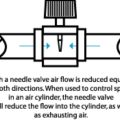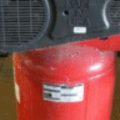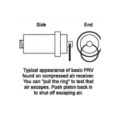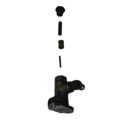Hey! This site is reader-supported and we earn commissions if you purchase products from retailers after clicking on a link from our site.
This page is about compressor auto drains, and how they help keep your industrial air system water-free. The words “auto drain” apply, in this case, to their use in draining compressor tanks, dryers, and filters.
Auto drains are used to replace the manual drains that are normally standard equipment on compressor tanks. This article will provide you with all the relevant information on automatic tank drain valves along with some examples readily available on Amazon.
Table of Contents
- Automatic Tank Drain Valve
- Automatic Drain Valve vs Manual Drain Valve
- Compressor Tank Auto Drains Installation & Setup
- Auto-Drains for In-Line Compressed Air Filters
- Auto Drain Valve Buying Considerations
- Auto Drain Valves Available on Amazon
- FAQs (Frequently Asked Questions)
Automatic Tank Drain Valve
Electric auto drains are typically configured as a 2 ported, 2 position valve that incorporates a timer. The auto drain timer can be set both for the frequency of operation, and for the length of time (the duration) that the auto drain valve is opened, to effectively and automatically rid the compressor tank of water that is generated by the compressing of air.
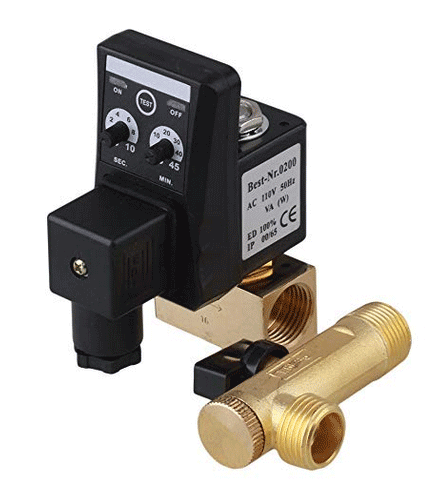
Many electric auto-drains come equipped with a wire and plug to allow them to be powered from a standard 120 VAC outlet. The auto drain can also be hardwired into a control system that could monitor the functioning of the auto drain automatically.
Automatic Drain Valve vs Manual Drain Valve
The receiver, or air tank, of your air compressor, normally comes equipped with a manual compressor tank drain. This manual tank or reservoir drain is typically located at the lowest spot of the air tank.
Have you ever busted a knuckle trying to drain the tank on a manual tank drain valve? Yeah, you know the location makes it almost inaccessible, but that’s not why the drain is there. Gravity works, and water generated by the pump and driven into the tank by the process of compressing air, will flow down to the lowest area in the tank. That’s where the tank drain should be!
In order to keep free water from accumulating inside the receiver, and this is particularly important for industrial compressed air applications in which large compressors can dump gallons of water into a tank daily, this manual tank drain should be opened at least once a day to allow the tank to drain all water completely.
Depending on the size of your compressor and the length of time that your compressor runs each day, it might be necessary to drain water more frequently than that. Better to drain it too often than not enough.
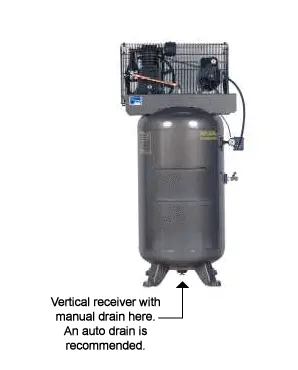
This strongly recommended daily ritual of manually draining a compressor tank is often overlooked by routine maintenance, not the least reason of which is the location of the tank drain. This will result in the scenario discussed on the pages of this site that refer to water and water problems here.
This is why an electric compressor tank auto drain valve is an almost must-have accessory for the compressor receiver in industrial applications, and certainly better than a manual valve. If you frequently use your air compressor in a home or garage workshop, then you really should have already invested in an auto-drain.
The key benefit automatic drain valves hold over manual drain valves is their automation. It can certainly be easy to forget to manually drain your tank after each use if you keep getting caught up in other jobs. With the auto drain valve, you have peace of mind. Without having to do anything, you’re keeping your air compressor tank free of water and eliminating any risks of possible corrosion.
Compressor Tank Auto Drains Installation & Setup
Installation of the auto drain is fairly simple. The existing manual drain is screwed out, and the auto drain is screwed into the same port.
Or, if the outlet on the manual drain is threaded, add a nipple and screw the auto drain onto the nipple. If you opt for this route, ensure that you leave the manual tank drain fully open.
Setting the time is straightforward as well. Typically there will be a timer knob, usually calibrated for hours and/or days on which you set the frequency of operation of the auto drain. Once a day? Perhaps twice a shift if the air compressor runs daily and frequently.
There will be another dial or knob to set the duration of the drain cycle. This dial is normally calibrated in seconds and/or minutes. This adjusts the length of time that the drain is open to void water and from the tank.
Receiver auto-drains will mean that the compressor tank gets drained of free water often enough to solve some water-related problems in the downstream, air-using applications, and without a maintenance person having to remember to do so.
How Often to Cycle Compressor Auto Drains?
When you’re setting up your auto drain, start by timing how long it takes to drain the reservoir using the existing manual tank drain valve after the compressor has run for half a shift.
When draining the tank is complete, there should be no free water coming from the drain, the drain bleeding air and water (yes, you want to have air pressure in the tank) until only a slight mist still exits the drain along with compressed air. Set the auto drain to run that same length of time and for one cycle each 1/2 shift.
Compressor Automatic Drain Valves & Energy Conservation
Monitor the operation of the auto drain to ensure that it does not run for more than a few seconds after all free water is blown out. If the auto drains continue to run after that time, all that is being accomplished is wasting expensively generated compressed air.
Auto-Drains for In-Line Compressed Air Filters
The standard drain for a compressed air filter is a manual one. This means that a maintenance person has to visit the location on a regular basis to ensure that free water and the “soup” of contamination that the filter strips from the air are drained from the filter bowl before it can be entrained back into the air stream.
An air filter auto-drain will ensure that the filter bowl is drained as frequently as necessary, without operator intervention, resulting in long-term positive effects on the downstream compressed air components that the filter precedes.
Some compressed air auto drains work on the float principle.
As water and contamination accumulate in the bottom of the bowl, it will ultimately lift afloat. The compressed air, under pressure in the bowl, will then vent to the atmosphere through the drain opening, blowing the water and debris from the bowl as it does. When the accumulated water is gone, there’s nothing left to “float” the valve operator, and it drops back into the orifice, sealing off the exit from the bowl.
The air pressure in the bowl will keep that drain hole sealed until such time as the water overcomes the air pressure by lifting the float, and the cycle repeats.
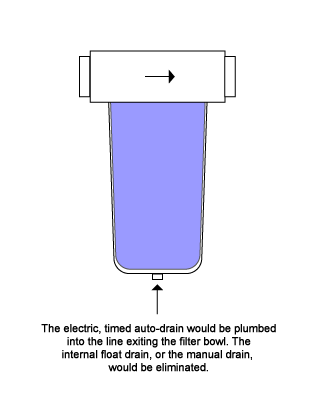
Some auto drains in air filters will only work to void the water in the bowl when the air system is depressurized, this allowing the float in this type of air filter to open the drain. Check with your vendor to see what type they offer, as, if you have a system that stays pressurized for long periods of time, this floating type of auto drain may not function frequently enough to rid the system of water.
In compressed air systems with high free water content and long up-time between system depressurization, you might want to consider using an electric, timed auto drain, the same type that is recommended for use in draining the compressor tank.
There will likely be environmental or safety issues relating to the outflow from the receiver auto drain or even the filter drain. Please dispose of drained fluids properly.
The water that exits the devices will contain a range of contaminants, including oil, so it is wise to vent them into a pail. Then the drained liquid can be disposed of properly and safely.
If you have crud and compressor oil, in your air system, that – along with water – gets to the compressor receiver and then into the airlines to the filter bowl. This accumulation, when exiting the tank or filter bowl when the drain cycles, may plug the outlets in the common drain. A more frequent cycle of draining will help prevent this.
If the frequency of cycle allows the material in the auto drain or float drain to dry out, this may cause the mechanism to stick shut, and your auto drain won’t work.
If a plugged drain becomes a problem for one of your drains, consider using an electrically actuated ball valve. The ball valve will have a much larger opening meaning it will be difficult to plug up.
Auto Drain Valve Buying Considerations
When searching for the right auto drain valve for your air compressor there are a few considerations Other than considering the different types of auto drain valves, whether that be a timed one or a float one. Or, should I say requirements, that you must ensure you vigorously check before purchasing. First of all, you must obtain an auto drain valve with the correct thread so that it fits onto your air compressor’s tank. Most auto drain valves will use threads that are widely used on air compressors like a 1/2″ male NPT inlet, though, it may be possible to use a reducer if necessary to make the connection.
You must also pay attention to the internal time and discharge time of the drain valve. The internal time is the measure of how frequently the auto drain valve opens up to release water, while the discharge time is the length of time it is opened. You want to obtain an auto drain valve that has an internal time range from 30 seconds to 45 minutes and a discharge time range from 0.5 seconds to 10 seconds.
Most air compressor auto tank drain valves will meet both these ranges, with the setup of the valve opening for 3 seconds every 30 to 45 minutes being the most popular across compressed air systems.
Note the maximum pressure your air compressor will operate at, or hold air at, and make sure that the auto drain valve is capable of operating at these pressures. Most valves should have a maximum operating pressure of above 200 PSI so you shouldn’t have any issues here.
Finally, consider what material you think is best for the body of the auto drain valve. Brass tends to be a very popular material due to its benefits of being exceptionally durable, resistant to corrosion, and its ability to withstand the high temperatures and pressures associated with compressed air.
Auto Drain Valves Available on Amazon
I have picked out a few auto drain valves readily available on Amazon. The first is this Amazon choice Automatic Electronic Timed Air Tank Water Moisture Drain Valve for Compressor.
- BRAND NEW 115 VOLT ELECTRONIC AUTOMATIC TIMER MOISTURE DRAIN FOR AIR COMPRESSORS AND AIR TANKS.
Prices pulled from the Amazon Product Advertising API on:
Product prices and availability are accurate as of the date/time indicated and are subject to change. Any price and availability information displayed on [relevant Amazon Site(s), as applicable] at the time of purchase will apply to the purchase of this product.
The second is this G1/2 DN15 Automatic Electronic Timed Drain Valve.
- G1/2 thread is widely used and can fit for most air compressors
Prices pulled from the Amazon Product Advertising API on:
Product prices and availability are accurate as of the date/time indicated and are subject to change. Any price and availability information displayed on [relevant Amazon Site(s), as applicable] at the time of purchase will apply to the purchase of this product.
Both these examples I have picked out from Amazon meet the buying considerations I previously described.
FAQs (Frequently Asked Questions)
This depends on the type of auto drain valve you have. The timed ones will work on your specific setup, commonly for air compressors, they’ll open for 3 seconds every 30 to 45 minutes. Others will work on the float principal. Where water and contamination accumulate in the bottom of the bowl, which ultimately lifts a float and allows the compressed air to vent out and blow the water and debris from the bowl.
Pneumatic auto drains work typically via a timer, they can be set to open for a certain amount of seconds every so long. In some cases, they may work by accumulating water and contamination in their bowl which eventually lifts a float and allows the pressurized air to force the water and contaminants out of the drain.
Yes, it is generally advised by all engineers or specialists on air compressors that your air compressor tank should be drained daily if not, after every use.
An auto drain valve is a valve attached to an air compressor’s tank that automatically drains the tank from water and contamination every so often. The interval at which it does so can be set on the drain valve itself depending on the type.
Additional valve reading:
- Types of Compressed Air Valves – Guide To Pneumatic Valves
- Pneumatic Flow Control Valves – What Are They, How Do They Work?
- Air Compressor Air Line Non-Return valves/Inline (In The Air Line) Air Check Valves Explained
- Check Valve Sizes
- What is Check Valve Cracking Pressure
- Air Compressor Troubleshooting Check Valve
- Air Compressor Unloader Valve Explained
- Unloader Valves On Twin V Piston Compressor Guide
- 5 3 Valves Explained
- 5-2 Air Valves
- 4-2 Compressed Air Valves
- 3-2 Air Valves
- Drawing a 5/3 compressed air valve
- Draw A 5/2 Air Valve
- Pneumatic Soft Start Valves
- Solenoid Pilot Air Valves
- Compressed Air Solenoid Valve Guide
- Needle Valve vs Ball Valve
- Globe Valve vs Ball Valve
- Globe Valve vs Gate Valve
- Butterfly Valve vs Gate Valve
If you have any questions regarding air compressor auto drain valves, please leave a comment below, with a photo if applicable, so that someone can help you!



